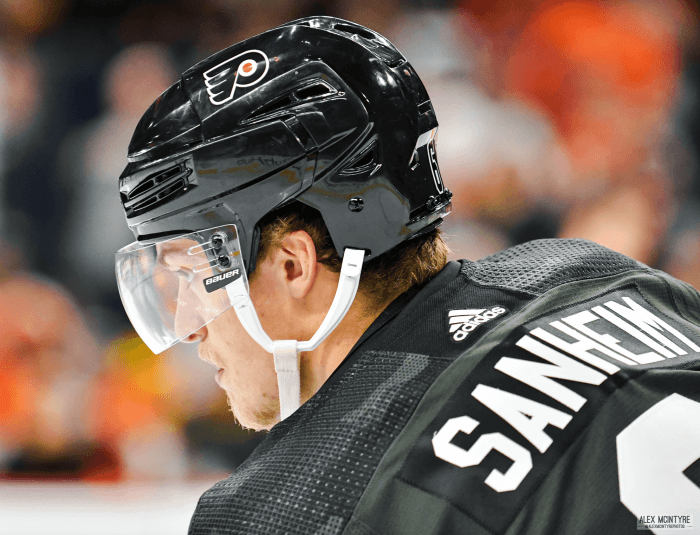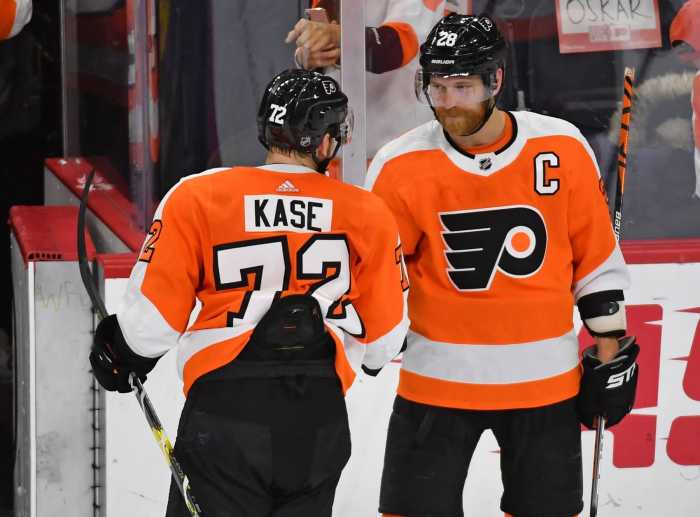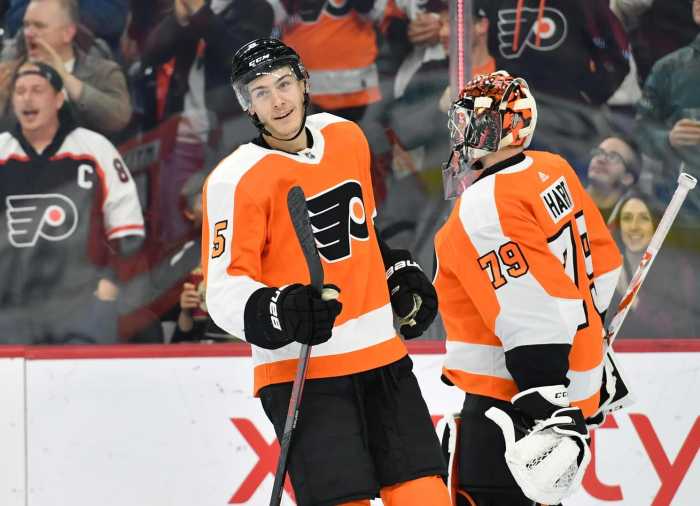Chuck Fletcher’s first year as General Manager of the Philadelphia Flyers has gone swimmingly. Signing key free agents, bringing in the proper mix of veterans on the blue line and up front, and adding valuable depth at the trade deadline. Fletcher has built a contender from top to bottom, and for the foreseeable future.
Fletcher set those wheels in motion during June of 2019. With so many restricted free agents to sign last offseason, Fletcher had his work cut out for him from the get-go. He signed Travis Sanheim in June, & Scott Laughton in July. In September, Fletcher finally cracked the code, signing Ivan Provorov. Three days later, he inked Travis Konecny.
Fast-forward almost an entire year, and he is at it again. Chuck Fletcher signed Oskar Lindblom on July 22 to a three year deal worth nine million dollars. Great value for a budding young player, the same concept shared between the Konecny, Sanheim, and Provorov contracts as well. Is Chuck Fletcher onto something here?
What’s the Angle Here?
It appears that Chuck Fletcher has an image of these players in his head, somewhere farther down the line. At the time of their deals, Provorov & Konecny were both 22, while Sanheim and Lindblom were both 23. TK and Provy are now locked up until they’re each 28 years of age, while Sanheim is a Flyer until the age of 25, and Lindblom the age of 26.
Fletcher likely views each of these players as key cogs in the Flyers machine. That makes it easy for him to rationalize locking them up, especially Konecny and Provorov to their long-term deals. Hextall was the “build for the future” guy, and now Fletcher is tasked with making the team a contender. However, these moves are indicative of Fletcher building for the future, with having the present in mind as well. Signing these two and locking them up for the prime of their career is a move that suggests just how confident Fletcher is in these players.
Lindblom and Sanheim are on shorter deals, but both are on the cusp of truly blossoming into their roles. Before the diagnosis, Lindblom had notched 11 goals in 30 games. Sanheim has grown into his role on the second pairing. Sanheim’s bridge deal was more about the circumstances and becoming victim to the numbers game, with Provorov and Konecny due for deals. He will get paid at the end of this deal. Lindblom’s deal is a move that Fletcher seems to make all too often now, where he’s betting on future production.
Fletcher’s Wager on the Future
The biggest common factor to all these deals is that Fletcher locked up four young players. Rewind back to when Chuck Fletcher was the general manager for Minnesota. He went Wild (pun intended) in free agency during the 2012 off season, signing both Zach Parise & Ryan Suter to 13 year contracts worth $98 million each, roughly $7.5mil per season. Eight years into those deals, and Fletcher learned his lesson. Not having to currently deal with those deals is a blessing, but not mimicking those same mistakes is an encouraging sign that Fletcher has learned from those debacles.
Fast forward seven years, and Fletcher dished out separate six year deals, worth $40.5mil and $33mil apiece. About half the term, about half the price, about half the risk. At the time Suter & Parise signed their deals, both of them were 28. Konecny and Provorov were both 22 at the time of signing their deals. Compare, you have two 28 year-old players signing on until they’re both 41 years old. On the other hand, you have two 22 year-olds signing for half the price, half the term, and their contracts run out when they’re both 28 years old.
Sure, the Provorov/Konecny pairing are at a different stage than the Parise/Suter pair were when they signed their deals. However, the fact that Fletcher didn’t extend a guy like Radko Gudas or Jori Lehtera over Provorov and Konecny means that one, he’s learned his lesson, and two, he’s a competent general manager (Not to mention, has a brain. Who would extend Gudas or Lehtera over TK or Provorov?)
Setting Up for Success
Having stud players signed to deals like this is a huge benefit to the future of the Flyers. Whereas one team pays their number one defenseman upwards of eight or nine million dollars a year, the Flyers have theirs locked up for under seven. Whereas also, one team has their leading scorer locked up at nine or ten million dollars per year, the Flyers had their leading scorer this past season playing for under six million dollars.
That money being saved by Fletcher will get allocated to areas of need, like signing Sanheim to a longer term deal, Philippe Myers when his contract is up, and locking up franchise netminder Carter Hart at the end of next year. Make no mistake, the moves Fletcher has made thus far have put the Flyers in a bit of a crunch. According to Capfriendly.com, as of July 24, the Flyers final cap space is $70,954. However, moves like signing Konecny, Provorov, Sanheim, and Laughton to team-friendly deals like this are what will help get him out of these pinches.
The Potential Heartbreak
The one downside to this, as a fan, is that these types of deals make it that much easier to deal each player in the last year of their contract. Look at Wayne Simmonds for example. Simmonds was on a six year deal with the Flyers, paying him a shade under four million dollars every year. When he entered the final year of his contract, everyone knew he was a prime candidate to be dealt. Matching his production with the price tag he came with, he was the perfect rental at the trade deadline.
Nobody wants to address this now, but it’s worth mentioning that depending on where the Flyers stand come the 2024/25 season, one or both of Konecny and Provorov could find themselves on the trading block with favorable contracts. Unpopular, absolutely. From a business standpoint, you can’t fault a move like this. Both players, 28 at that point in time, would be in the prime years of their career. If Provorov remains the minute-logging monster that he is, and Konecny stays around the top of the Flyers in points, Chuck Fletcher has two prime trade chips come the 2025 NHL trade deadline.
Again, this is quite the unpopular opinion. Likely, using TK and Provorov as trade chips isn’t the main motivator behind signing them. Regardless, there’s no denying that these types of contracts come along with that type of option because of how team-friendly they appear.
Fletcher’s Thought Process
Chuck Fletcher surely sees something in these young players or else he wouldn’t have signed them. Signing them to a lengthy term shows his trust in them as well. It also shows just how savvy he can be. With those six year deals for Provorov and Konecny, Fletcher locked up key components to the Flyers team for the long haul. He’s banking on the type of players they will become, as opposed to paying them based off of what they had done before their ELC’s were up.
It’s an incredibly smart move, but also comes with some risk involved. Fletcher gets them for longer term, which is risky if they don’t pan out. However, if he had signed them short term, they tore the house down and he extended them again, Fletcher has to shell out more money and runs the risk of losing them to a higher bidder. What Fletcher is doing is betting on how good they’re going to be.
The Oskar Lindblom signing is just the latest in a string of moves that support the theory that Chuck Fletcher sees something in the younger players of the Flyers. The next domino to fall will be Nolan Patrick, who is a restricted free agent at the end of the 2019/20 season. Will Chuck Fletcher follow suit and dish out a longer term deal for Patrick? Will he give him a one year “prove it” type deal? Whatever deal he gets will tell the fanbase just how Fletcher feels about Patrick’s fit with the organization moving forward.
Mandatory Credit – © Eric Hartline-USA TODAY Sports























